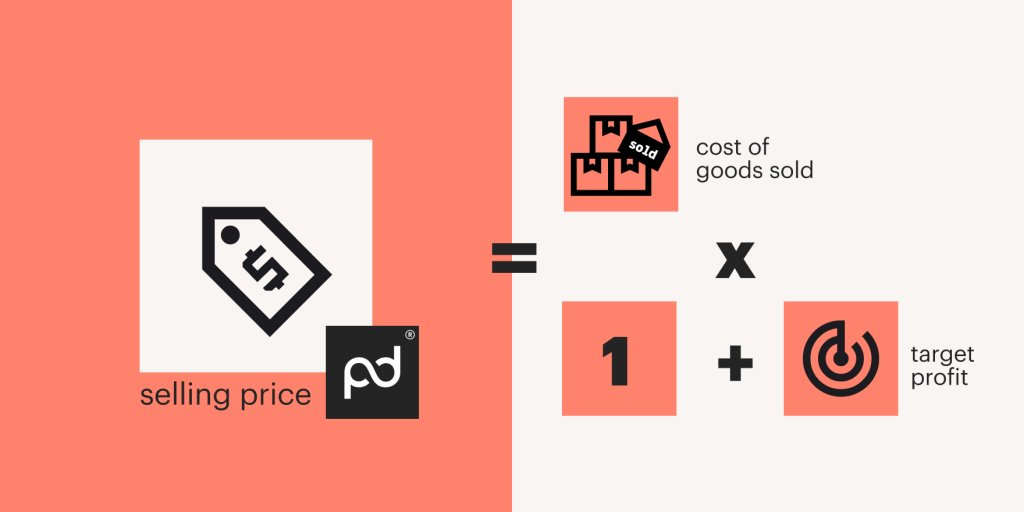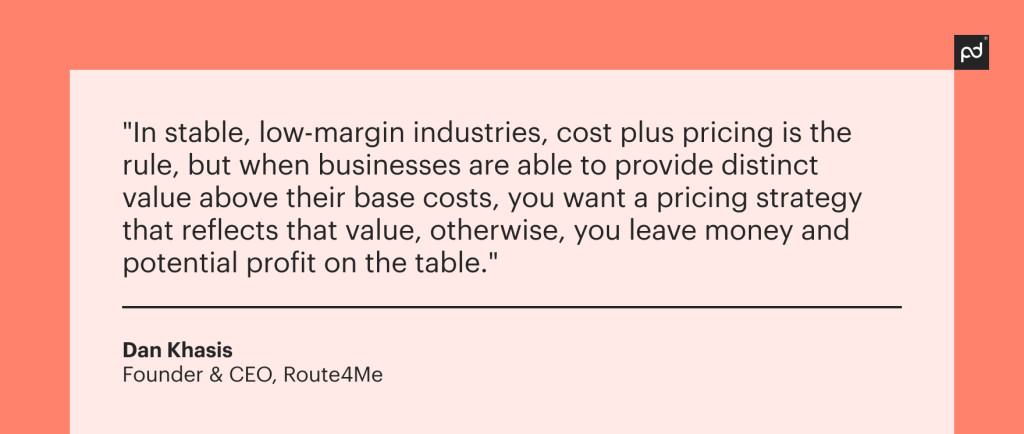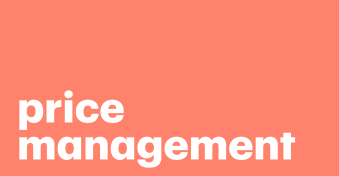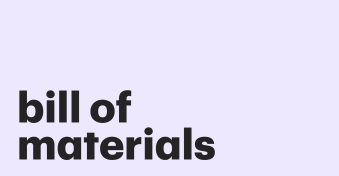We’ve all compared pricing to find the best deal or value for our money. But we can’t just slap a price tag on something and expect to hit our revenue targets.
Many more factors contribute to pricing decisions and finding the most effective pricing strategy for your business.
Your pricing model influences your revenue and brand perception when customers compare your products and pricing to your competitors.
When you want to determine the best selling prices for your products or services, three of the most popular models are cost-based pricing, competitor-based pricing, and value-based pricing.
While the best pricing strategy will depend on several factors, cost-plus pricing is one of the most simple and commonly used methods.
Let’s explore how this pricing strategy works, look at some cost-plus pricing strategy examples, how it compares to other methods, and which industries may benefit from cost-plus pricing.
What is cost-plus pricing?
Simply put, cost-plus or markup pricing is the cost to create your product or service plus your desired markup or profit margin.
To determine your selling price, you must take the following elements into account:
- Cost of goods sold (COGs) is the direct cost of creating a product or service. This can include raw materials, storage costs, overhead costs, labor costs, and any other internal costs.
- Margin or markup: A fixed percentage added to the costs. You determine this, and it can vary by product or service line.
How do you calculate cost-plus pricing for a business?
Once you’ve determined the cost of goods sold and your markup percentage, it’s simple to calculate the selling cost using the cost-plus method.
Cost-plus pricing formula
Plug these values into the following formula to determine your selling price.
Selling price = (Cost of goods sold) * (1 + target profit)
Target profit should be in a decimal format, e.g. (20% = .20)
Selling price = (Cost of goods sold) * (1 + target profit)
Target profit should be in a decimal format, e.g. (20% = .20)

Cost-plus pricing example
Here are two examples from two industries to illustrate how the cost-plus pricing formula works.
Manufacturing
Let’s consider a furniture manufacturing company that produces wooden chairs.
Unit cost to produce one chair:
- Raw material costs: $50
- Labor: $20
- Overhead (utilities, rent, etc.): $10
- Total cost: $80
- Desired profit margin: 30%
Selling price calculation:
Selling price = (Cost of goods sold) * (1 + target profit)
$80 * (1 + .3) = $104
The selling price for each chair, using cost-plus pricing, is $104.
Software/Tech
Let’s consider a SaaS company offering project management software.
- Developer salaries: $50,000
- Cloud hosting: $10,000
- Software licensing: $5,000
- Customer support: $15,000
- Total cost: $80,000
- Desired profit margin: 40%
Selling price calculation:
$80,000 * (1 + .4) = $112,000
Selling price = (Cost of goods sold) * (1 + target profit)
The selling price for the single software product, using cost-plus pricing, would be $112,000.
Why use a cost-plus pricing strategy?
Why should you use a cost-plus pricing model, and which industries are best served by this strategy?
Let’s take a look at some of the advantages of cost-plus pricing.
Benefits of cost-plus pricing
As you can see from the straightforward formula above, using cost-plus pricing to determine the price of a product is fairly simple.
In addition to being easy to use, cost-plus pricing helps companies realize profits and establish customer trust.
Easy to use
The necessary components to calculate your selling price with cost-plus pricing are your costs and your desired profit margin.
This means you can compute pricing fairly quickly without extensive competitive research or data on market demand.
“One of the biggest pros of cost-plus pricing is its simplicity, you calculate the cost to produce the product, then add a percentage on top for profit,” Tiago Pita, Brand Director at Whole Food Earth, says. “It’s straightforward as you calculate the cost to produce the product, then add a percentage on top for profit. This is especially useful for companies with stable production costs, like in the food industry, where ingredients and packaging costs are fairly consistent.”
Built-in profitability
Assuming you consider all of your costs (both fixed and variable costs and additional expenses like marketing), cost-plus pricing ensures you will see a profit based on those costs and your markup.
“Another advantage is that it ensures predictable margins,” Tiago says. “By setting a fixed markup, you know that every sale is covering your costs and providing a profit. This can make financial planning and budgeting easier.”
Builds customer trust and transparency
The cost-plus pricing model is easy for your customers to understand. They know it’s based on the cost to produce your products. Changes in selling prices mean increased production costs.
“Adopting a cost-plus pricing method helps businesses to build trust with customers,” Jeremy Bogdanowicz, Founder and JTB Studios, says. “For instance, they can explain to customers why they increased their products’ prices. Their process can be entirely transparent, earning trust and respect from customers. They can show how the production or addition of new features increased the prices.”
Disadvantages of cost-plus pricing
As straightforward as it is, there are some drawbacks to using this method.
Doesn’t demonstrate product value proposition UVP
Since you determine your selling price solely based on your production costs plus your margin, you do not always account for your product’s value to your customers.

PandaDoc helped River Pools streamline their operations and boost efficiency by 60%
A cost-plus pricing model would only account for production costs and discount the value PandaDoc offers customers.
Neglecting to consider this in your pricing can lead to you underselling the true value of your product.
Doesn’t consider competition
When customers are in the market for a product, they will often compare prices across multiple vendors.
Cost-plus pricing doesn’t use competitor prices or data to determine the selling price. This can be a drawback since it can lead to inconsistent pricing on similar products.
“In highly competitive markets, such as tech, where pricing needs to be more flexible, cost-plus pricing can work against you,” Mushfiq Sarker, Chief Executive Officer of LaGrande Marketing, says. “Competitors might offer similar products or services at a lower price, making your markup seem too high. That’s why this method is usually better suited for industries where customers are less price-sensitive, and the cost of production plays a larger role in determining the final price.”
Doesn’t allow price segmentation
In some industries, especially software, a product may have a different price depending on the segment it caters to. This is because the perceived value of your product varies in different market segments.
These customer groups have varying needs and resources, so having the same pricing across segments only partially captures your value-based pricing potential.
Doesn’t account for product innovation
If your selling price is only based on your production costs and margin, you may neglect customer feedback that could influence your prices.
When you consider customer needs and feedback, you can enhance your product, increase your customers’ value, and adjust the selling price accordingly.
Based on the reasons above, there may be more appropriate pricing strategies for SaaS companies than cost-plus pricing.
Software can make a person’s job easier or help a team be more efficient. If a company doesn’t account for perceived customer value, they will likely undersell their product.
A product’s value can vary based on customer needs, especially across different segments. For that reason, SaaS companies may be better served using tiered or value-based pricing (which we’ll cover below.)
“Cost-plus pricing is commonly used in industries with stable, identifiable costs, such as manufacturing,” Parker Gilbert, CEO and Co-Founder of Numeric, an AI accounting automation company, says. “In these sectors, the cost-plus model can provide a predictable profit margin and ensure that costs are covered. However, in dynamic industries like SaaS, value-based or market-driven pricing may be more effective.”
Which industries commonly use cost-plus pricing?
Like any pricing model, cost-plus pricing has its advantages and disadvantages. That means it works well for some industries but not for others.
“In my experience, cost-plus pricing works well when you’re in an industry where transparency, consistency, and cost control are priorities,” Mushfiq says. “It’s a straightforward way to ensure profitability without constantly revisiting your pricing strategy. But like anything in business, it’s important to know when it fits and when it doesn’t because pricing should always align with the needs of your specific market.”
Cost-based pricing may be beneficial when:
- Costs don’t fluctuate by a large margin, and the business isn’t contending with factors like inflation or supplier issues.
- A business offers unique goods or services where competitor or historical data isn’t readily available to influence pricing.
Industries that commonly use cost-based pricing include department stores, grocery stores, clothing stores, and manufacturing companies, which use their production costs and add a profit margin to calculate their selling prices.
Cost-plus pricing company example
Everlane is an ethically sourced clothing retailer that uses a cost-plus pricing strategy.
With the goal of transparency, Everlane shares their product costs and their price markup, which is generally 2 to 3 times the cost to produce the products.
Cost-plus pricing vs. other pricing models
Cost-plus pricing isn’t the best option for certain industries (like SaaS as we mentioned above), so it’s important to compare other strategies to ensure you’re not making pricing mistakes.
Cost-plus pricing vs. value-based pricing
Value-based pricing is a more customer-centric approach than cost-based pricing. It takes perceived customer value into account in the selling price.
There is no straightforward formula to calculate the selling cost. Using value-based pricing, organizations must identify the benefits a product or service offers to a customer.
- Tiered pricing: Product or service packages with different features and value depending on customer needs or business size. For example, offers tiered pricing with different features and price points based on customer segments and needs.
- Subscription-based pricing: Subscribers are charged a recurring fee based on their access level or how they use the product or service (think Netflix or other streaming services).
Value-based pricing is commonly used in industries like SaaS, technology, healthcare, consulting services, and luxury goods.
Cost-plus pricing vs. target costing
Target costing is like working backward because you already know how much people are willing to pay for your product.
For example, you want to create a task management app to help people organize their to-do lists. You’ve determined your customer’s willingness to buy is at a price point of $5 per month to use your app.
Using target costing, you would figure out how to build the app so it costs you less than $5 per month. Maybe you use a simpler design or limit some of the features to reduce the cost.
Target costing is often used in consumer electronics, construction, and automotive industries.
Cost-plus pricing vs. marginal cost pricing
Marginal cost pricing is when a company charges just enough to cover the small extra cost of selling one more product or adding one more customer.
Let’s look at a clothing retailer as an example:
A clothing store has already spent money to rent space, hire employees, and buy inventory. These are fixed costs that don’t change regardless of how many items they sell.
At the end of the summer, they have a few shirts left that they want to sell before they bring in their fall inventory. Since the fixed costs are covered, they just want to cover the extra cost of selling the last few shirts. This could include something small like the price of hangers.
Using marginal cost pricing, the store would sell these shirts for just a little more than the cost of the hangers. So if it costs the store $2 more to sell one extra shirt, they might sell the shirt for $5.
This is likely much less than they sold the shirts for originally, but still allows them to cover the cost to sell the last few items.
In addition to retail, marginal cost pricing is also often used in manufacturing.
Cost-plus pricing vs. market-based pricing
Market-based pricing considers what customers are willing to pay and also looks at how much competitors are charging vs. the price to produce a product. It’s kind of like keeping up with the Joneses.
Let’s say you own a coffee shop. You’re trying to figure out the price for a seasonal beverage like your new-and-improved pumpkin spice latte. While it only costs you about $2.50 to make, you see other coffee shops offering it for $5 or $6.
You meet them in the middle and price yours at $5.50.
You may find market-based pricing in the automotive industry, food service, retail stores, and airlines.
| Pricing Model | Description | Common Industries |
|---|---|---|
| Cost-plus pricing | Price is set by adding a fixed profit margin to the cost of production. Simple and straightforward. | Retail (grocery, clothing), manufacturing |
| Valued-based pricing | Price is determined based on the perceived value to the customer, not just production costs. Can involve tiered or subscription pricing models. | SaaS, tech, healthcare, consulting, luxury goods |
| Target costing | Start with the price customers are willing to pay and work backward to ensure costs fit. | Consumer electronics, construction, automotive |
| Marginal cost pricing | Price is set just high enough to cover the extra cost of selling one more item or adding one more customer. Often used for surplus or excess inventory. | Retail (end-of-season sales), manufacturing |
| Market-based pricing | Price is determined by looking at what customers are willing to pay and competitor pricing, balancing customer expectations with competitive offerings. | Automotive, food service, retail, airlines |
Cost-plus pricing and finding the best strategy for your business
Cost-plus pricing offers a straightforward, easy-to-implement pricing method that may be ideal for businesses with stable costs or consistent margins.
However, its simplicity does come with limitations, which means it may not be the right option to account for market demand, perceived value, or competition.
When considering the best pricing model for your business, it’s essential to evaluate your industry, customer base, and competitive landscape to determine which strategy best aligns with your business goals.
No matter which pricing strategy you use, PandaDoc can help you create fast, accurate quotes and generate proposals to close more deals.
Our quoting software helps you integrate items from your product catalog and implement tailored pricing strategies.
Learn more about how you can use PandaDoc to sell more with tailored pricing; sign up for a free, personalized demo.
Disclaimer
PandaDoc is not a law firm, or a substitute for an attorney or law firm. This page is not intended to and does not provide legal advice. Should you have legal questions on the validity of e-signatures or digital signatures and the enforceability thereof, please consult with an attorney or law firm. Use of PandaDoc services are governed by our Terms of Use and Privacy Policy.


